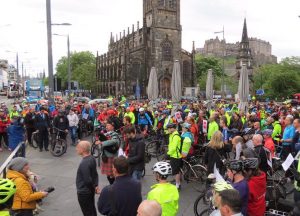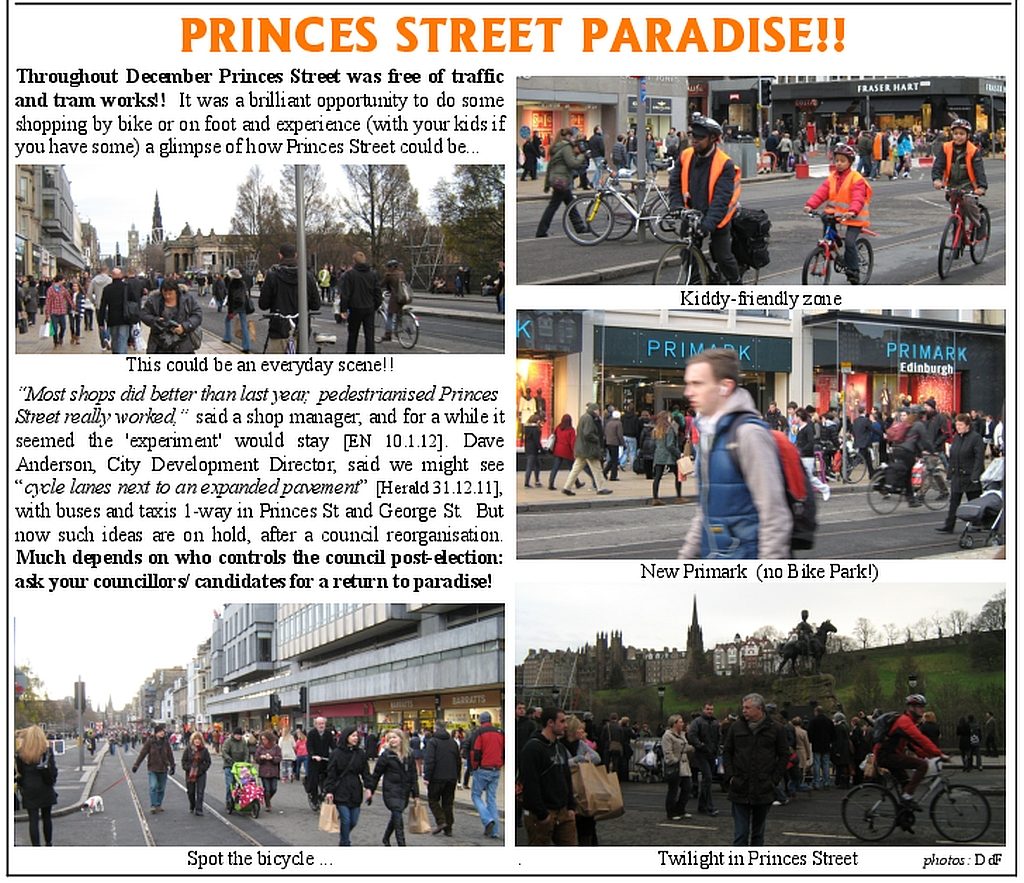Plans are underway to try and improve the safety of Edinburgh’s tramline system for people travelling by bike…

Memorial event for Zhi Min Soh, June 2017 photo: Chris Hill
Following the tragic death of Edinburgh University medical student Zhi Min Soh this summer at the West End junction, Edinburgh Council promised to investigate measures to reduce the toll of tramline cycling crashes throughout the system. Also, Transport Minister Humza Yousaf offered to give the Council any appropriate assistance.
Subsequently, a motion on this (motion 9.1) was passed unanimously at the first meeting of the new Council – at which we had a deputation – and a detailed report on proposals is due at the October Transport Committee.
It is an unfortunate fact that, despite our strenuous efforts 10 years ago, the tramline layout was designed without proper consideration to cycling (or walking). As a result, although many improvements can be made, the system will never be as bike-friendly as it could and should have been.
Spokes has now met with Council officers, where we learned that proposed measures have been divided into stages 1-4 below, the first to be implemented rapidly, whilst later stages will be firmed up and their timescales clarified as design, consultation and, in some cases, legal processes are undertaken.
1. Measures which can be implemented rapidly, without needing legal processes, agreement from other bodies, and so on.
These measures should start to appear at the end of September. They will be monitored to identify any problems encountered and any modifications needed, and the Council will welcome feedback.
We were delighted to hear the Council appreciates that many crashes are due in part to traffic pressures – a vital point which Spokes has picked up from victims who have contacted us. Traffic pressures can force a cyclist unintentionally onto the tramline, often at a highly dangerous angle, or can prevent the cyclist positioning themself properly for an intentional crossing. The proposed immediate measures take this into account, and include…
- New signage throughout the system emphasising the need for people on bikes to be given sufficient space – including space behind when the motor vehicle cannot overtake. These are not standard signs, and so need a government ‘ok’ – but given the Minister’s support it is hoped that this will happen very quickly.
- A media campaign reinforcing the message, possibly including on the backs of buses.
- Red surfacing to indicate to cyclists where crossing is recommended, and the need for as good an angle as possible – and to make motorists more conscious of the fact that cyclists may be needing to cross tramlines. Rather to our surprise, the bright red surfacing at Haymarket has reduced tramline crash reports to Spokes drastically. However most other potential red surfacing locations are much less straightforward and it will be vital for these locations to be monitored carefully – for example a possible downside is whether some cyclists assume that the colour gives right of way.
2&3. Measures which require significant approvals and/or discussion/ agreement with other bodies such as police, tram and bus operators, etc.
For example, measures to give bikes a start over motor traffic, such as advance stop areas and possibly advance traffic lights. Also some physical measures where traffic regulation orders are not needed, such as possibly modifying the island outside Haymarket Station. We expect details will appear in the report to the October Transport Committee.
4. Major changes needing Traffic Regulation Orders, significant physical changes to roadways and kerbs, public consultation, etc
There are no detailed proposals yet, but this may tie in with major city centre changes following section 5 of the above motion passed at the first meeting of the new council. In particular, Spokes will continue to press for reduced motor traffic and for segregated cycle provision, notably for Princes Street [see below].
Projects will very likely include significant change at the West End junction (section 1 of the above motion). We are pressing for this to incorporate a cycle crossing (for example, as in our Bulletin 123 drawing) from Lothian Road/Rutland Square to Hope Street, connecting to the planned West-East cycleroute and it could also include the long-promised Hope Street pedestrian crossing.
WHAT YOU CAN DO
- If you have specific ideas for short-term or longer-term measures, tell your councillor and ask them to feed your ideas to relevant officers. Find your (Edinburgh) councillors here.
- In particular, consider the points made in the Spokes deputation to the June Council meeting.
- If you are involved in, or know someone involved in, a tramline crash – please do get it reported officially and send a copy to Spokes.
NOTE ON TRAMLINE ‘FILLERS’
People frequently suggest use of plastic or other tramline ‘fillers’ and pass on a variety of links found on the internet. We understand that Edinburgh Trams has investigated a number of makes and not found any which are effective, can withstand tram wheel pressure, and, most importantly, which work on the type of rail used in Edinburgh’s onroad tram sections (there are successful options for offroad sections). We support this view – see our Spokes note on tramline fillers. Of course, it is important always to keep an open mind for new developments which do resolve the problems, and if anyone in future hears of fillers which do work successfully in this type of on-road rail, please contact Edinburgh Trams.
PRINCES STREET: CAN IT BE TRAFFIC-FREE?
Princes Street was entirely traffic free for the whole of December 2011! [Graphic from Spokes Bulletin 112]

